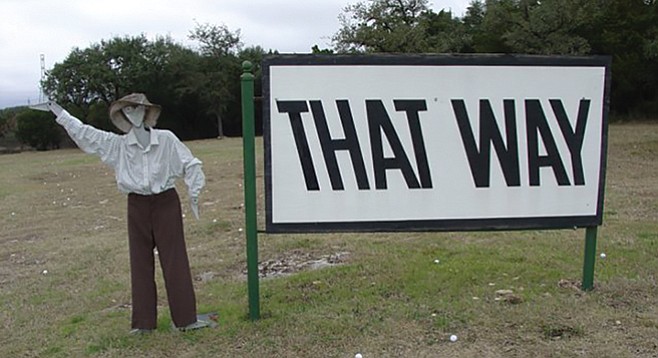 Facebook
Facebook
 X
X
 Instagram
Instagram
 TikTok
TikTok
 Youtube
Youtube

Never liked golf in high school or college; it was something old people did. Old people dressed up in clown clothes, drove their station wagons to the country club, climbed into golf carts, snaked around fairways, descended from the cart now and then to swing at a golf ball, then double-quick time to the bar and booze. I regarded golfers as absurd.
The last time I played golf was absurd, too, but a spontaneous kind of absurd. Myself, Patrick Finely, and girl friends of the moment were driving along the Mendocino coast. A discreet sign said, “Something Something Golf Course.” I executed a tire-screeching hard left, entered Golf World.
I still remember the tally. After 18 holes I sauntered into the clubhouse with a very acceptable 129 penciled on my scorecard.
I felt satisfied with that and have not perceived a need to hone my golf skills since. Which didn’t stop me from covering golf. There were PGA tournaments at Torrey Pines, amateur golf tournaments around San Diego County, San Diego State women’s golf, and the rest. That was fun. Any sport played by people who are extraordinarily good at what they do is fun to watch as long as you’ve got great seats. And since I rarely write about sports per se, what I do is find a moment that captures the scene, knowing how to play golf was beside the point.
Okay, back to my 129 score and subsequent golf life not lived. Enter Groupon. There was this Groupon pitch in my email. Weekday round of golf for two, with cart, plus one sandwich, one drink each, $49.
Ring up best bud, explain all this can be his for $24.50. He, too, has not played golf since arthropods made landfall. He, too, sees the necessity of coming back to a game not played. I mention cost-effectiveness again and call for a vote, “Whaddya think?” Golf junket is approved by acclamation.

Turns out, while we were away, golf has been cratering. A few weeks back, the Washington Post published an article: “Why Americans Fell Out of Love with Golf.” Consider the following facts found in Drew Harwell’s story: number 1 manufacturer of golf clubs and clothes, TaylorMade, recorded a 28 percent drop in sales last year. According to the Sports & Fitness Industry Association, “The number of young people, aged 18 to 30, playing the game has sagged nearly 35 percent over the last decade,” and, “More golf courses closed than opened in 2013 for the eighth straight year.”
A May 2014 Newsmax story says: “Only 24 new golf courses were built in the U.S. last year, while almost 160 shut down....” The National Golf Foundation says 200,000 players under the age of 35 abandoned golf last year. Ominously, 650,000 men quit playing golf. True, 260,000 women began playing, and the PGA thanks you, but that still comes out to a net loss of near 400,000 golf consumers.
Some other factors: playing 18 holes of golf takes four hours, more or less. Only the homeless, retired, and already rich have that kind of time on their hands.
Golf takes money. And more money. The American middle class is being extinguished, which leads us back to the homeless, retired, and already rich.
Golf is exceedingly hard to learn. Requires years. And years. David Fineg is proprietor of Ten Cups Golf Center, which is not a golf course or range anymore, but lives on in cyberspace, where, “Grass grows much more slowly, less mowing gives owner more time to hit virtually great shots.” Fineg is author of Golf’s Containment Theory & the Nonsense Zone. He lives in Austin and is available for golf lessons. “The lessons are private and cost $50 plus the expenses associated with one round of golf at the course of your choosing. If, at the end of the round, you don’t feel you have received value for your money, you owe me nothing. (And, I will pay for my golf).”
You have to respect a man who offers that kind of guarantee.
Bottom line: How long will it take me to break 100? Fineg divides players into three groups. Group A are players that play five times a year and practice 20 times a year. Group B are players that play 20 times a year, practice 100 times. Group C are players that play 100 times a year, practice 200 times a year.
How long to break 100? Group A, 4½ years; group B, 3½ years; group C, 2½ years.
Mr. Fineg lives in Austin. I’ve emailed and asked if he ever gets out to the West Coast. If he does, I’ll let you know.


Never liked golf in high school or college; it was something old people did. Old people dressed up in clown clothes, drove their station wagons to the country club, climbed into golf carts, snaked around fairways, descended from the cart now and then to swing at a golf ball, then double-quick time to the bar and booze. I regarded golfers as absurd.
The last time I played golf was absurd, too, but a spontaneous kind of absurd. Myself, Patrick Finely, and girl friends of the moment were driving along the Mendocino coast. A discreet sign said, “Something Something Golf Course.” I executed a tire-screeching hard left, entered Golf World.
I still remember the tally. After 18 holes I sauntered into the clubhouse with a very acceptable 129 penciled on my scorecard.
I felt satisfied with that and have not perceived a need to hone my golf skills since. Which didn’t stop me from covering golf. There were PGA tournaments at Torrey Pines, amateur golf tournaments around San Diego County, San Diego State women’s golf, and the rest. That was fun. Any sport played by people who are extraordinarily good at what they do is fun to watch as long as you’ve got great seats. And since I rarely write about sports per se, what I do is find a moment that captures the scene, knowing how to play golf was beside the point.
Okay, back to my 129 score and subsequent golf life not lived. Enter Groupon. There was this Groupon pitch in my email. Weekday round of golf for two, with cart, plus one sandwich, one drink each, $49.
Ring up best bud, explain all this can be his for $24.50. He, too, has not played golf since arthropods made landfall. He, too, sees the necessity of coming back to a game not played. I mention cost-effectiveness again and call for a vote, “Whaddya think?” Golf junket is approved by acclamation.

Turns out, while we were away, golf has been cratering. A few weeks back, the Washington Post published an article: “Why Americans Fell Out of Love with Golf.” Consider the following facts found in Drew Harwell’s story: number 1 manufacturer of golf clubs and clothes, TaylorMade, recorded a 28 percent drop in sales last year. According to the Sports & Fitness Industry Association, “The number of young people, aged 18 to 30, playing the game has sagged nearly 35 percent over the last decade,” and, “More golf courses closed than opened in 2013 for the eighth straight year.”
A May 2014 Newsmax story says: “Only 24 new golf courses were built in the U.S. last year, while almost 160 shut down....” The National Golf Foundation says 200,000 players under the age of 35 abandoned golf last year. Ominously, 650,000 men quit playing golf. True, 260,000 women began playing, and the PGA thanks you, but that still comes out to a net loss of near 400,000 golf consumers.
Some other factors: playing 18 holes of golf takes four hours, more or less. Only the homeless, retired, and already rich have that kind of time on their hands.
Golf takes money. And more money. The American middle class is being extinguished, which leads us back to the homeless, retired, and already rich.
Golf is exceedingly hard to learn. Requires years. And years. David Fineg is proprietor of Ten Cups Golf Center, which is not a golf course or range anymore, but lives on in cyberspace, where, “Grass grows much more slowly, less mowing gives owner more time to hit virtually great shots.” Fineg is author of Golf’s Containment Theory & the Nonsense Zone. He lives in Austin and is available for golf lessons. “The lessons are private and cost $50 plus the expenses associated with one round of golf at the course of your choosing. If, at the end of the round, you don’t feel you have received value for your money, you owe me nothing. (And, I will pay for my golf).”
You have to respect a man who offers that kind of guarantee.
Bottom line: How long will it take me to break 100? Fineg divides players into three groups. Group A are players that play five times a year and practice 20 times a year. Group B are players that play 20 times a year, practice 100 times. Group C are players that play 100 times a year, practice 200 times a year.
How long to break 100? Group A, 4½ years; group B, 3½ years; group C, 2½ years.
Mr. Fineg lives in Austin. I’ve emailed and asked if he ever gets out to the West Coast. If he does, I’ll let you know.
Comments